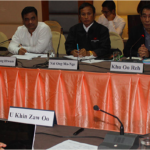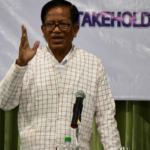By Sai Wansai/Shan Herald Agency for News | December 15, 2017
As 2017 comes to an end the ethnic armed conflict that have plagued the country for decades seems to be escalating, rather than reducing. The related ongoing peace negotiation process is also met with stagnation, instead of positive development. Moreover, the ethnic conflict epicenter which has shifted from the Karen State, after peace process started in 2011, to the Shan and Kachin States for the last few years now even expanded to include the Chin and Arakan or Rakhine States.
Armed conflict actors
The armed conflict actors pitted against the government’s Military or Tatmadaw are categorized into the 8 Nationwide Ceasefire Agreement (NCA) signatory Ethnic Armed Organization (EAOs) and 13 non-signatory EAOs, which again are divided into two alliances, the four-party United Nationalities Federal Council (UNFC) and seven-party Federal Political Negotiation and Consultative Committee (FPNCC).
NCA was signed by Karen National Union (KNU), Karen National Liberation Army/Peace Council (KNLA/PC), Reunification Council of Shan State (RCSS), Pa-O National Liberation Organization (PNLO), Chin National Front (CNF), All Burma Students’ Democratic Front (ABSDF) and Arakan Liberation Party (ALP) on October 15, 2015 when President Thein Sein’s government was in power.
Members of the UNFC are New Mon State Party (NMSP), Karenni National Progressive Party (KNPP), Lahu Democratic Union (LDU), and Arakan National Council (ANC).
Members of the FPNCC, also popularly known as Pangkham (or Panghsan) alliance are Kachin Independence Organization/Army (KIO/KIA), National Democratic Alliance Army (NDAA), Shan State Progress Party/Shan State Army (SSPP/SSA), Palaung State Liberation Front/Ta’ang National Liberation Army (PSLF/TNLA), Myanmar National Democratic Army (MNDAA), Arakan Army (AA), and the United Wa State Army (UWSA) (the alliance’s leading organization).
The National Socialist Council of Nagaland-Khaplang (NSCN-K) is not involved in any ethnic armed group alliance and Wa National Organization (WNO) has dissolved, as it has joined the United Wa State Army (UWSA) as a Wa armed group.
Conflict situation in ethnic states
Kachin/Shan States: The ceasefire break-down between the Kachin Independence Organization/Army (KIO/KIA) and the Tatmadaw in 2011 and the renewed Kokang conflict of 2015 have made Shan and Kachin State a primary war zone since a few years back.
The Tatmadaw and KIA clashed in both the Kachin State and northern Shan State. During the year, fighting concentrated in the western Kachin State around Tanai township, where taxes on illegal gold and amber mines levied by the KIA’s 2nd Brigade constitute the group’s second largest source of income after those from jade mines.
Another facet of war in northern Shan State is the continuation of on and off inter-ethnic conflict between the NCA signatory Restoration Council of Shan State (RCSS) and non-signatory Ta’ang National Liberation Army (TNLA), which have started out almost immediately in the aftermath of NCA signing in October 2015.
Strangely enough, the FPNCC members, the Shan State Progress Party (SSPP) and the TNLA clashed in December over territorial dispute, although later the latter said that was just a misunderstanding.
Rakhine/Chin States: The war expanded to the Chin and Rakine States as Arakan Rohingya Salvation Army (ARSA) entered the internal conflict fray by storming the government outposts in August, killing nearly a dozen or so security personals. The Tatmadaw responded with massive retaliation employing area clearance operations, which drove more than 600,000 Rohingya into the Bangladesh as refugees. This has created an intense, massive international backlash in a scale not known before, in various international settings and threatening to make use of the “Responsibility to Protect” instrument and reemploy sanctions, that were lifted just a few years back, again.
Arakan Army (AA) penetration into the Rakine State, following the ouster of NCA signatory Arakan Liberation Party (ALP) troops from their major outpost on 22 August, and positioning itself in the adjacent Paletwa of Chin State, has created another war front that developed into a full blown conflict between the Tatmadaw and the AA.
The recent massive ten battalions Tatmadaw retaliation offensive operations started when on November 8, the AA ambushed a Tatmadaw boat convoy in Paletwa Township, on Kaladan River, killing 11 Tatmadaw soldiers and wounding 14 more, including a killed university student and wounded three women.
Sagaing Region: In September, the NSCN-K clashed with the Indian Border Guard, some 10-15 kilometers inside Myanmar, Sagaing Region, on the outskirts of Langkhu village, where an NSCN-K leader was killed. The Indian side said the Naga suffered heavy causalities.
Mon State: In February, the Mon National Liberation Army (MNLA), armed wing of the New Mon State Party (NMSP), abandoned two small military bases, located in Thanbyuzayat Township and near Three Pagodas Pass on the Myanmar-Thailand border, which served as checkpoints and also collected tax, due to the Tatmadaw’s pressure. The actions of the Tatmadaw on February 14 were believed to be retaliation for the celebration of Mon National Day two days earlier.
In August, the Tatmadaw reportedly pressured the NMSP not to hold the 70th anniversary of the Mon Revolution on August 7 outside of its headquarters. The NMSP charged that 200 Tatmadaw soldiers entered nearby villages in response to NMSP’s military parade on the said anniversary. Tensions were diffused after a representative of the military met the NMSP leadership in Ye Township, Mon State, on August 16.
Karen State: The Democratic Karen Benevolent Army (DKBA) splinter group and the Karen Border Guard Force clashed on and off all through out the year and further complicated the matter as the latter included the Tatmadaw’s officers in its leadership, including the from time to time entering into the KNU controlled areas following skirmishes and pursuance of the splinter group.
Assessment of the second 21CPC
The signatory EAOs were not happy with the second 21st Century Panglong Conference (21CPC) held in May 24-29, 2017.
The first Union Peace Conference (UPC) was held during the Thein Sein era. The second and third peace conference were held by the National League for Democracy (NLD) regime, which changed the name into Union Peace Conference – 21st Century Panglong (UPC-21CP), popularly known as 21st Century Panglong Conference. And since then it has been referred to the second peace conference is first 21CPC and the third as second 21CPC.
Chief among the issues were the 37 principles acceptance by the 21CPC, supposed to be the first part of Pyidaungsu (Union) Accord that should be the guideline for the future federal union formation, which again must be endorsed by the parliament, was taken on the basis of consensus, rather than through voting process, as prescribed in the Framework for Political Dialogue.
This was followed by the discussion of non-secession and federal army issues. However no solution was reached and these issues were omitted from final statements. The majority of the ethnic bloc, which includes the EAOs and ethnic political parties, rejected the non-secession proposal and argued that secession is contrary to the 1947 Panglong Agreement spirit, that highlighted the “full autonomy in internal administration for the Frontier Areas”. The major ethnic groups see the original union as voluntary that has to be reinstalled and not a forced one as it is now the case.
Regarding federal army issue the Tatmadaw wanted a single “Union Army” or “Standard Army” with the Bamar-dominated status-quo setup as usual and the commanding leadership and pushing for disarmament, demobilization and reintegration (DDR), which mainly aimed at dismantling the EAOs. But the EAOs were keen to employ security sector reform (SSR) aiming at integration into the federal army, taking orders from the federal government and allowing them to keep their armed forces and taking part in the defense of the country, including their respected home states.
Government efforts
On November 11-12 a delegation from the government traveled to UWSA headquarters in Pangsang, National Democratic Alliance Army (NDAA) headquarters in Mongla and met their leaders to persuade them to participate in the peace process. But both insisted to negotiate under their alliance FPNCC as a group and rejected the NCA-based peace process approach.
Regarding the UNFC, the government conducted a lengthly 17 months negotiation on how to accommodate the former’s NCA amendement proposal but so far there has be no success. Reportedly, the two parties were unable to overcome the terminology of “federal democratic Union with full guarantees” as preferred by the UNFC, and “a Union based on democracy and federalism” as stated in the NCA and preferred by the government. At this writing, the UNFC is trying to meet the State Counselor and the Commander-in-Chief, in a last-ditch effort to iron out the differences.
Perspective
To sum up, the armed conflict situation as a whole would likely escalate, due to the Tatmadaw’s hard decision to root out the AA from Paletwa and Rakhine State and bent on continued offensives on the four-party Northern Alliance- Burma (NA-B), in the Shan and Kachin States, according to the Tatmadaw’s Commander-in Chief repeated statements.
The peace process would also be sluggish if not stagnated, as the nearly 80% of the EAOs’ fighting forces are not part of the negotiation process, due to the Tatmadaw’s hard-line exclusion of the NA-B and policy not to meet the FPNCC as a group as insisted by it. And even if the government and the 8 NCA signatories were able to iron out their procedure implementation differences of the upcoming third 21CPC, the gathering will still be only partially represented which cannot be all-inclusive.
Thus, if the reconciliation and political settlement are to be achieved, the government and the Tatmadaw would have to be more accommodating in including the FPNCC and as well the UNFC into the peace process fold. And furthermore, they would need to be committed to the federal system of government and not the unitary system of democracy with federalism trappings, which the ethnic nationalities have always pointed out with suspicion.
The recent November China separate visits of the Commander-in-Chief and the State Counselor, including the Chinese using of veto power in the United Nations Security Council (UNSC) to protect Myanmar from international anger and possible sanctions couldn’t be taken as the Chinese might be ready to pressure the FPNCC to toe the Myanmar government’s NCA-based peace process approach. As China position has always been only to persuade and not to push the stakeholders involved. Besides, the FPNCC members would map its own policy as it has shown time and again and only pursue what they think will be in its best interest.
The year of 2018 would likely be a year of continued turbulence and challenge as well. But on how the powers that be would steer the country out of the troubled political waters will depend on its sophistication, understanding and application of the internationally accepted norms and appropriate move in the given situation.
This article originally appeared on Shan Herald Agency for News on December 15, 2017






